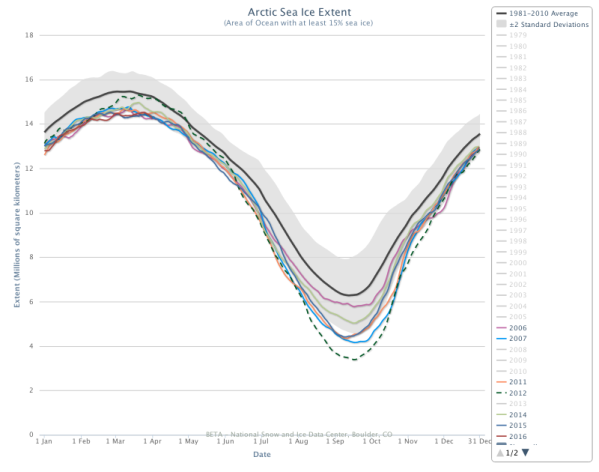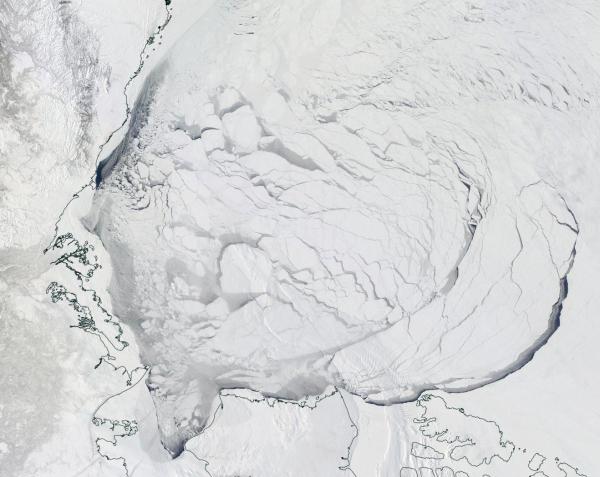Conditions Promoting the Arctic Sea Ice Collapse Are Exceptionally Strong This Spring
15
April, 2016
It
didn’t take long for Arctic sea ice to start to respond to a
fossil-fuel based accumulation of hothouse gasses in the Earth’s
atmosphere. For since the 1920s, that region of ocean ice along the
northern polar zone has been in a steady, and increasingly rapid,
retreat. Rachel Carson wrote about the start of the Northern
Hemisphere ocean ice decline in her ground-breaking 1955 book — The
Edge of the Sea.
But
it wasn’t until the late 1970s that consistent satellite
observations began to provide an unbroken record telling the tale of
Arctic sea ice decline. The
National Snow and Ice Data Center, The
Polar Science Center (PIOMAS),
Japan’s JAXA, The
Danish Meteorological Institute,
and others have
since that time provided a loyal recording of the stark impact
human-forced warming has had on this sensitive and critical region.
Perhaps
the most poignant and direct telling of this tale has been provided
in the form of Andy
Lee Robinson’s tragic and resonant re-rendering of sea ice volume
declines as measured by PIOMAS.
Others, like
Neven over at the Arctic Sea Ice Blog,
have heroically and often thanklessly provided the essential
week-to-week analysis of this tragic decline. Rising to the
task of a necessary telling of a key chapter in the human tale that
our mainstream media sources have all-too-often neglected.
Before we go on to today’s update on an Arctic Ocean ice cap that
is now in a critically weak condition, I want to add one last mention
— these scientists, analysts, experts, and creative and
artistically inclined laymen have done the right thing. They were the
modern-day prophets providing the critical warning that has been
oft-ignored.
A
Tale of Devastating Loses
It’s
a warning that has been written in the record of the ice itself. A
decline that since 1979 has followed a steepening descent curve. An
overall downward trend punctuated by the abrupt and severe loss years
of 2007 and 2012. A trend that has, nonetheless, featured a few weak
challenges in the form of pseudo-recovery years like 2008, 2013, and
2014. A precipitous loss that, all too soon, will likely terminate
with abrupt finality in temporally-expanding blue ocean events.
Periods when little or no sea ice is observed on the surface of
oceans and seas within the Arctic.
(After
the warmest Winter and early Spring period on record, Arctic sea ice
extent, area and volume are now at or near new record lows. With
abnormal heat persisting and with the ice showing an extraordinary
lack of resiliency, there appears to be a heightened risk that Arctic
sea ice will hit new record all-time lows by September and October of
2016. Image source:NSIDC.)
Why
should we talk about blue ocean events now? Well, we have only to
look at the sea ice record to find that substantial losses have
occurred during single years. Years when Arctic heat hit new peaks —
lining up with severe adverse weather conditions to take a terrible
toll on the ice. Years like 2007 when nearly 2 million square
kilometers of ice was lost over the previous year and 2012 which
featured about 800,000 square kilometers of extent lost below the
2007 low mark. And if a blue ocean event does happen, it will be
during one of these severe loss years.
Extremely
Frail Sea Ice During the Spring of 2016
2016
and 2017 could be years when such precipitous declines occur. Heat
from an extraordinarily powerful El Nino already skipped over the
weakening atmospheric wall of the Jet Stream to invade the High
Arctic during Winter of this year. As a result, Winter and Springtime
Arctic temperatures are
currently at their warmest levels ever recorded.
All
this extra heat is doing a number on the ice. Sea ice extent, volume
and area, which had experienced a false recovery during the years of
2013 and 2014, have again retreated to seasonally record low levels.
In particular, the new near record low seasonal volume measure is
disturbing. For while area and extent measure the expanse of surface
ice as visible from above, volume measures the ice in three
dimensions — giving a better idea of overall resiliency or lack
thereof. It’s worth noting that the PIOMAS volume measure is based
on a model of assimilated observational data. And, as with any model,
there are a few assumptions built in. But overall, PIOMAS has tended
to provide data that has matched with other observational findings.
(Extreme
fracturing of Beaufort sea ice over recent days has
come after a record warm Arctic Spring and Winter and during a period
when a powerful high pressure system has been breaking and compacting
the ice. Image source: LANCE-MODIS.)
Sea
ice frailty seen in the measures is also verified by current
satellite observations of the ice surface. This frailty is
particularly visible in the region of the Beaufort Sea north of
Alaska and Canada. There, extensive fracturing of the ice is
clearly visible in yesterday’s MODIS satellite shot.
Here we find huge regions of thin ice and open water as the torquing
influence of a powerful high pressure system has turned the greatly
weakened Beaufort ice into a sea of ice cubes.
During
recent years in the post 2012 timeframe, Beaufort ice has shown a
considerable lack of resiliency to fracturing. This is particularly
disturbing as, historically, the Beaufort Sea has tended to house the
thickest, toughest ice in the Arctic. If such a great former bastion
for the ice can now be torn to ribbons by the slightest fluxes of
wind and weather, then the sea ice is, indeed, in a rather wretched
state. And last year, just this kind of early fracturing and warm up
in the Beaufort greatly contributed to an overall return to the trend
of an Arctic sea ice death spiral in 2015.
Last year’s April cracking event caused a lot of fragmented multi-year ice to be transported all the way up to the Chukchi Sea (see here), leaving a vulnerable looking barrier on the Pacific side of the Arctic. When this was followed by an early heat wave in May (see here), the ice in the Beaufort and Chukchi Seas received a beating it never really recovered from during the rest of the melting season. This was also because continental snow had melted out really quickly, making it possible for warm winds to blow in from the land.
Heating
From Both Water and Land
Compared
to last year, this year looks quite a bit worse. A wide-ranging
Beaufort break-up is happening on the back of last year’s losses
and is concurrent with new record and near record low sea ice extent,
area and volume values and is happening during a period in which
Arctic heat has hit new all-time highs. The result is a risk of
compounding melt factors hitting the greatly weakened ice all at the
same time.
Locally,
the kind of widespread fracturing we now observe can result in a loss
of protective reflectivity for the sea ice. As the Springtime sun
rises and more of its direct rays fall upon the ice, darker thin ice
patches and areas of open water will absorb more of the solar heat.
That extra heat will then go to melting the islands of thicker ice
that remain.
This
situation can generate a compounding effect of ice losses if weather
conditions and atmospheric temperatures line up. In addition, loss of
the thicker sea ice cap during break-up can result in the ventilating
of heat from the warmer waters beneath the ice. In fact, it is the
heating of waters beneath the sea ice by means of current transport
of warming ocean waters from around the world and into the Arctic
that is one of the chief drivers of Arctic Ocean ice losses as the
globe has been forced to warm by human fossil fuel emissions. So not
only does an ice crack up the Beaufort reduce the ice’s resiliency
to the sun, it also tears the lid off the deeper ocean warming rising
up from below.
(Lower
albedo due to ice fracturing results in more of the sun’s rays
being absorbed into the ocean surface. A warmer Arctic Ocean surface
then radiates more heat into the surrounding environment. Such
conditions can result in periods when temperatures over the,
previously colder and solidly frozen, Arctic Ocean are far warmer
than even over land masses on the verge of tipping into a springtime
thaw. Image source: Earth
Nullschool.)
During
Arctic Spring, when land surfaces are now retaining snow cover even
as the sea ice breaks up, the effect of lower albedo and ocean heat
ventilation can be found in the form of warmer temperatures over thin
ice, broken ice, and in open water regions when compared to nearby
land masses. Such a condition of newly added heat over ocean zones
can have substantial impacts come Summer if melt-favorable weather
patterns continue to hold sway. The result is a kind of melt synergy
developing between the land, the waters, and the sun. Early on,
during Spring, the warmer ocean zone weakens ice and provides warm
air pools that aid in the initiation of snow melt over adjacent land.
Then, as land warming ramps up, the warm winds coming from regions of
early snow withdrawal provide further pressure to the already greatly
weakened ice.
A
Big Burly High as the Final Ingredient
Weather
patterns that favor melt during Spring and Summer include powerful
high pressure systems dominating large regions of the Arctic. And for
much of the past week, an extremely intense high in the range of 1040
to 1045 mb has stooped over the Beaufort, torqued the ice, and
developed the kind of strong clockwise wind flow that has tended to
result in fracturing, ice compaction, and the opening of darker ice
and open water areas (please
read Neven’s fantastic recent blog on this observation here).
This
kind of weather system is the last ingredient necessary to trigger an
early, rapid melt for the side of the Arctic where the last of the
thick, old ice now remains. And it appear that, for at least two
weeks, such conditions will hold strong sway over the Beaufort.
So
overall, more and more conditions are lining up to deliver a ramping
up of melt pressure on the Arctic sea ice. Record atmospheric heat,
early break-up, record low or near record low area extent and volume,
and a powerful high pressure system over the Beaufort do not at all
bode well. In fact, this looks like a near perfect early season
set-up for a record melt in 2016 should this clearly ominous trend
continue.
Links:






No comments:
Post a Comment
Note: only a member of this blog may post a comment.